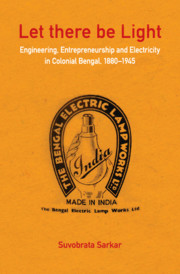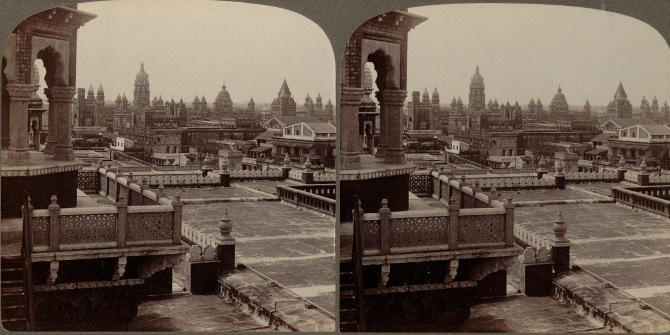In Let There be Light: Engineering, Entrepreneurship and Electricity in Colonial Bengal, 1880-1945, Suvobrata Sarkar examines the emergence of electricity between 1880 and 1945 in Bengal, exploring the impact of its arrival upon industry, entrepreneurship, the education of engineers and the professionalisation of engineering. Thoughtful and impressively researched, the book pushes the boundaries of the historiography of science and technology in India, writes Tirthankar Roy.
Let There be Light: Engineering, Entrepreneurship and Electricity in Colonial Bengal, 1880-1945. Suvobrata Sarkar. Cambridge University Press. 2020.
 From the nineteenth century, many scientific ideas and technologies that had transformed material life in Western Europe and America entered India. An extensive railway system revolutionised transportation. The electric telegraph made communication cheaper and faster. Textile mills using steam-powered machines emerged in the port cities. In the early twentieth century, cheap household gadgets like the sewing machine and bicycle, as well as an office machine, the typewriter, shaped middle-class ideas of a better life.
From the nineteenth century, many scientific ideas and technologies that had transformed material life in Western Europe and America entered India. An extensive railway system revolutionised transportation. The electric telegraph made communication cheaper and faster. Textile mills using steam-powered machines emerged in the port cities. In the early twentieth century, cheap household gadgets like the sewing machine and bicycle, as well as an office machine, the typewriter, shaped middle-class ideas of a better life.
The diffusion of electric power from around World War One was another example of the transfer, but one that had a different order of impact. For one thing, electricity had diverse uses. Industries and mines wanted to switch to a cheaper form of energy. Entrepreneurs recognised that electricity promised new business opportunities. Electric lighting lengthened the working day. Consumers wanted electric light for the home. For another, the production of electricity needed a business system to enable the enormous investment required. India’s cosmopolitan business milieu could rise to that challenge to some extent.
The process of transfer of technology from Britain to India raises several questions. A large and relatively recent body of scholarship attempts to answer these. Most historians who write on the topic seem to hold that the production, use and operation of these technologies changed in character in the process of the transfer, that a sort of indigenisation or Indianisation of Western ideas was at work. A subset of recent studies also claims that the emergence of science and engineering education in late-twentieth-century India owed to this indigenisation that began in colonial times.
Electricity has so far been an overlooked example in this scholarship. Suvobrata Sarkar’s new book, Let There be Light, changes that. A significant part of the book deals with electricity and the impact of its arrival upon industry and entrepreneurship. The material and the arguments go beyond this one example, however. The education of engineers and the professionalisation of engineering are the main interest of the study. With turn-of-the-century Bengal as the context, the book presents an engaging narrative on that dual process.

The story has two parts. The first part runs from roughly 1847 (the start of the Thomason College in Roorkee) until World War One. In these years, indigenous engineering education was limited to specific needs for civil engineers to build bridges and canals, and mechanical engineers to operate the railways. The British colonial government of India supplied a sparse framework for education, and those who decided on the pedagogy were torn between making competent apprentices and making graduate engineers. There were mental blocks to doing much more. The colonial government did not think much of the aptitude of middle-class Indians for technical work. British industry relied heavily upon on-the-job training rather than polytechnics. And an open border to skilled migrants had ensured an easy supply of foreign workers for the technical jobs inside the factories and mines.
Despite resistance from the top, a change had begun on the ground. A government college had appeared in Shibpur near Calcutta in 1856, which functioned as a semi-autonomous engineering college from 1880 (then named Bengal Engineering College, now the Indian Institute of Engineering Science and Technology). As Calcutta industrialised, both the industry and the people who ran the college pushed for increasing the supply of locally trained technical personnel. Industrial needs demanded diversification into electrical, chemical and mining engineering. While a limited expansion did happen, the government also pursued the idea that Indians would be better off going on a scholarship to Europe. Several Bengali young men took these scholarships and excelled in their studies and jobs. Their return, in a few cases to Shibpur itself, added to the credibility of the demand for indigenous education.
The second phase of the Indianisation story unfolded in the interwar period. World War One ended with a vague British promise to do more for Indian development, which translated into educational initiatives. As political power decentralised, Indian politicians and intellectuals lobbied hard for industrialisation on Indian terms. They wanted training, education, institution-building, skill development and reduced reliance on foreign technicians. Industrialisation and Indianisation became interlinked demands. Together, industrialisation and Indianisation became an ingredient in Indian nationalism. Interestingly, the indigenous entrepreneurs who had moved into offbeat fields and needed a specially trained workforce had mixed views about the role of education and research. They were torn, as were administrators a generation before them, between the apprenticeship model and the research-lab model.
Educationists readily embraced the second model. As the story ends, in the 1940s, the second model had found a credible expression in the College of Engineering and Technology, Jadavpur. A nationalist association was behind the start and growing reputation of this landmark institution. The inspiration was no longer artisanal Britain, but the research university of the USA. The Massachusetts Institute of Technology (MIT) recognised the Jadavpur degree as an equivalent of its own.
Through these pathways, the indigenisation of engineering education progressed in the interwar period. By the time independence came in 1947, the indigenous component in the technical and engineering workforce, both in public service and in private enterprises, was so prominent and so vocal as a lobby, that they could push the case for more public investment in engineering education. Independent India’s pursuit of industrialisation, with a heavy accent upon chemicals, metals and machinery production, would not be possible without these preconditions.
Let There be Light tells this story over five substantive chapters, and an introduction and conclusion. Sarkar delves deep into a variety of sources, including the archives of the Public Works Department, contemporary writings in English and Bengali periodicals, biographies and reports. These sources mesh into five case studies. The Shibpur college, the College of Engineering and Technology, Jadavpur, and the emergence of a discourse on indigenisation of engineering occupy Chapter One. This is followed by studies of two influential entrepreneurs, Sir R.N. Mookerjee (an alumnus of Shibpur) and Sir P.C. Ray, who held different views on what type of personnel the Indian industry needed (Chapter Two). Chapters Three and Four explore the electrical utility industry and the expanding uses of electricity, and Chapter Five examines the coming of age of the demand for engineering education with an Indian face in the 1940s.
The book offers many interesting statements on the legacy of the colonial times for postcolonial India. One wished for a more systematic treatment of the subject. The assertion that ‘the pattern of technological development (or underdevelopment?) of post-independence India depends […] upon its inherited structure of techno-science from the British Raj’ (2) is credible but intriguing. What is ‘underdevelopment’ doing in this sentence? I have a speculative answer to offer based on what I read in the book.
I am fascinated by an obsession with ‘quality’ of education, the accent on being world-class, that animated the discourse in the colonial times, both among the Indian nationalists and the British imperialists. The word ‘quality’ appears many times in Let There be Light. International contact and comparisons were needed for that emphasis on quality. Delivering quality in a world where most innovations happened outside Indian borders required constant comparisons. I suspect that as India adopted a heavily protectionist developmental regime after 1947, the international connection and comparison were not so important anymore, and quality dropped down in priority. Technical universities turned into mass-producing degree-giving teaching shops.
In 1945, the Bengali intellectual and nationalist Binoy Kumar Sarkar called Jadavpur ‘the Indian MIT of today’ (234). In 2020, MIT was the world’s number one university, and Jadavpur ranked 651-700. One cannot help thinking that a strength that derived from India’s cosmopolitanism in the colonial times was squandered away by an insular, occasionally xenophobic and overconfident, nationalist educational policy. This is not a criticism of the book. I hope to provoke the historians of technology to rethink the postcolonial without illusions.
What it sets out to do, Let There be Light does with competence and skill. It is a really good book. The narrative is fascinating, and the direct writing style does justice to the story. Thoughtful and impressively researched, the book pushes the boundaries of the historiography of science and technology in India, in that part of the emerging world that had once been ruled by the European colonial powers.
Note: This review gives the views of the author, and not the position of the LSE Review of Books blog, or of the London School of Economics.
Image Credit:Photo by Patrick Fore on Unsplash.







